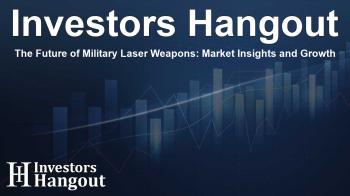The Future of Military Laser Weapons: Market Insights and Growth

Current Trends in the Military Laser Weapons Market
As technology continues to evolve, the military laser weapons market is seeing substantial advancements. The demand for these weapons, which was valued around USD 6.4 billion recently, is projected to skyrocket to approximately USD 15.88 billion by 2034. This growth represents a compound annual growth rate (CAGR) of about 9.2%, spanning from 2025 to 2034. Industry leaders, including Custom Market Insights, highlight several factors driving this transformation.
Technological Innovations Leading the Market
One of the primary forces behind the military laser weapons market surge is the integration of high-power lasers with existing military platforms. Instead of developing entirely new systems, defense agencies are retrofitting vehicles such as tanks, ships, and aircraft with modular laser weapon systems. This strategy accelerates deployment timelines and reduces costs while enhancing battlefield efficiency.
Rising Demand for Precision
In recent years, the use of directed-energy weapons has significantly increased due to their precision and lower operational costs compared to conventional options. For instance, military laser systems are being deployed to effectively neutralize drones—especially in urban environments where collateral damage must be minimized. The growing prevalence of unmanned aerial vehicles (UAVs) enhances the need for fast-acting laser systems that can provide an immediate response against potential threats.
Investment in Laser Technologies and Efficiency
Investment in advanced power generation and cooling technologies is also a key component of the military laser weapons market evolution. As militaries aim to deploy lasers capable of intercepting missiles and other threats, challenges associated with power supply and thermal management must be addressed. Companies are now focusing on innovations in energy storage and cooling methods to maintain the reliability and mobility of their laser systems.
Market Segmentation Insights
The military laser weapons market is segmented across various dimensions, including product type, platform, power level, end user, and regional distribution. Each segment offers unique opportunities and challenges. For example, high-energy lasers (HEL) are geared towards land, naval, and airborne platforms, while low-energy lasers are increasingly being used for non-lethal applications.
End Users and Strategic Partnerships
The primary end users of military laser systems include the army, air force, navy, and special forces. Furthermore, strategic global partnerships between nations, like NATO initiatives, are facilitating advancements in laser weapons technology. These collaborations aim to share resources and speed up the testing and deployment of laser systems while also fostering international interoperability among allied forces.
International Trends Shaping the Landscape
Globally, mixtures of economic and security concerns, especially in regions like Asia-Pacific and LAMEA (Latin America, Middle East, and Africa), are contributing to market growth. Countries in these regions are significantly investing in military technology improvements to address their respective national security concerns.
Challenges Facing the Industry
While the market shows promise, several challenges could impede growth. These include ethical and legal debates surrounding the use of laser weapons, particularly concerning potential unintended harm to civilians. Additionally, limitations imposed by atmospheric conditions can affect the efficacy of laser systems, as their operations heavily depend on clear visibility.
Opportunities for Growth
The military laser weapons market strategy may expand into non-lethal applications, catering to scenarios involving crowd control and the neutralization of enemy equipment without causing significant injury or damage. It’s predicted that advancements in artificial intelligence and machine learning will complement these systems, enhancing their operational capabilities further.
Future Outlook
The military laser weapons market appears robust as defense budgets continue to favor investments in directed energy technologies. This expenditure reflects a broader trend toward modernization and technological integration that could redefine warfare in the coming years.
Frequently Asked Questions
What is the current size of the military laser weapons market?
The market was valued at approximately USD 6.4 billion recently and is set to grow significantly.
What factors are driving the growth of the military laser weapons market?
Technological advancements, increased demand for precision, and strategic international collaborations are central to market growth.
What are the main segments of the military laser weapons market?
The market is segmented by product type, platform, power level, and end user, each presenting unique opportunities.
Which regions are seeing the most growth in military laser weapons?
Asia-Pacific and LAMEA regions are rapidly expanding their investment in military laser technologies due to security concerns.
What are the potential challenges facing the military laser weapons market?
Ethical concerns, atmospheric conditions affecting performance, and competition with other advanced weapon technologies pose challenges.
About The Author
Contact Kelly Martin privately here. Or send an email with ATTN: Kelly Martin as the subject to contact@investorshangout.com.
About Investors Hangout
Investors Hangout is a leading online stock forum for financial discussion and learning, offering a wide range of free tools and resources. It draws in traders of all levels, who exchange market knowledge, investigate trading tactics, and keep an eye on industry developments in real time. Featuring financial articles, stock message boards, quotes, charts, company profiles, and live news updates. Through cooperative learning and a wealth of informational resources, it helps users from novices creating their first portfolios to experts honing their techniques. Join Investors Hangout today: https://investorshangout.com/
The content of this article is based on factual, publicly available information and does not represent legal, financial, or investment advice. Investors Hangout does not offer financial advice, and the author is not a licensed financial advisor. Consult a qualified advisor before making any financial or investment decisions based on this article. This article should not be considered advice to purchase, sell, or hold any securities or other investments. If any of the material provided here is inaccurate, please contact us for corrections.

